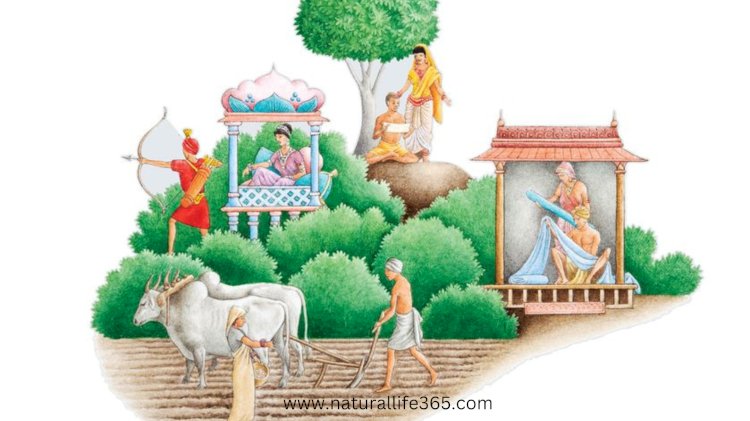Understanding the Indian Caste System
A comprehensive guide to understanding the Indian caste system. Explore its origins and how the British colonialism affected the Indian society.

The Indian caste system is a deeply rooted social hierarchy that has influenced the cultural, economic, and political landscape of India for millennia. Understanding the caste system is crucial for anyone interested in the complexities of Indian society, as it provides insight into the historical context, social dynamics, and ongoing struggles for equality and justice in the country.
Historical Background
The origins of the Indian caste system trace back thousands of years to the ancient Vedic period, which dates around 1500 BCE. The early Vedic texts, particularly the Rigveda, mention the Varna system, a hierarchical structure that divided society into four primary groups based on occupation and duty: Brahmins (priests and teachers), Kshatriyas (warriors and rulers), Vaishyas (traders and agriculturists), and Shudras (laborers and service providers). This Varna system was initially more flexible and was intended to organize society and allocate responsibilities rather than enforce rigid social divisions.
As centuries passed, the Varna system evolved into a more complex and stratified structure. The Manusmriti, a key legal text composed around the 2nd century BCE, codified the caste system and emphasized strict social order based on birth. This marked the beginning of the hereditary caste system, where an individual's caste was determined by birth and dictated their occupation, social interactions, and marital prospects.
Over time, the four primary Varnas were subdivided into thousands of Jatis, or sub-castes, based on specific occupations, local customs, and regional variations. These Jatis further entrenched the caste system into the daily lives of Indians, creating an intricate web of social hierarchy and interdependence.
The British colonial period, beginning in the 18th century had a profound impact on the caste system. British administrators documented and categorized the diverse social groups in India, solidifying caste distinctions through censuses and official policies. The British also introduced reforms that both challenged and reinforced caste norms and the introduction of Western education.
So, British colonial rule in India had a significant impact on the caste system, which altered its dynamics, Britishers did contribute to its entrenchment and the complexities observed in modern India.
You can also read Historical Atrocities in India Under British Rule
Structure of the Caste System
The caste system in India is a complex social hierarchy that has evolved over millennia. At its core, the system is structured around dividing society into distinct groups based on occupation and social status. This section will explore the primary elements of the caste system, including the four main Varnas, the concept of Jatis, and regional variations.
The Four Primary Varnas
1. Brahmins
- Role and Duties: Traditionally, Brahmins are the priestly class, responsible for performing religious rituals, teaching, and maintaining sacred knowledge. They hold a high social status due to their association with spiritual and intellectual pursuits.
- Sub-Groups: Brahmins are divided into various sub-groups based on regional and sectarian differences, such as the Saraswat Brahmins, Gaur Brahmins, and Iyengar Brahmins.
2. Kshatriyas
- Role and Duties: Kshatriyas are the warrior and ruling class. Their primary duties include protecting society, governing, and upholding justice. Historically, they were the kings and soldiers of Indian society.
- Sub-Groups: Within the Kshatriya Varna, there are numerous sub-groups, including Rajputs, Marathas, and the Nairs of Kerala.
3. Vaishyas
- Role and Duties: Vaishyas are the merchant and agricultural class. Their responsibilities include trade, commerce, and farming. They play a crucial role in the economic prosperity of society.
- Sub-Groups: Vaishyas are divided into various sub-groups such as Agarwals, Oswals, and Maheshwaris, often linked to specific trade or business communities.
4. Shudras
- Role and Duties: Shudras are the laboring class, responsible for serving the other three Varnas through various forms of manual labor and service. Historically, they were artisans, craftsmen, and service providers.
- Sub-Groups: The Shudra Varna encompasses numerous occupational sub-groups, including weavers, potters, and blacksmiths.
Jatis: The Sub-Castes
1. Definition and Significance
- Concept: Jatis, or sub-castes, are smaller, more localized groups within each Varna. They are based on specific occupations, local customs, and kinship networks.
- Importance: Jatis play a crucial role in social identity and daily life, dictating marriage alliances, dietary practices, and community interactions.
2. Interdependence
- Socio-Economic Role: Each Jati traditionally had a specific role within the local economy and society, creating a system of interdependence where various Jatis provided essential services and goods to one another.
- Social Mobility: Although the caste system is generally rigid, there have been instances of social mobility within Jatis, particularly through economic success or regional migration.
Regional Variations
1. North India
- Caste Dynamics: In North India, the caste system tends to follow the traditional Varna structure more closely, with distinct divisions among Brahmins, Kshatriyas, Vaishyas, and Shudras.
- Prominent Jatis: Examples of prominent Jatis include the Jats and Yadavs in the northern plains, each with its own socio-economic status and historical background.
2. South India
- Caste Dynamics: South India features a more complex and diverse caste system, with numerous local variations and a significant presence of non-Vedic castes and tribal communities.
- Prominent Jatis: Notable Jatis in South India include the Nairs of Kerala, the Vanniyars of Tamil Nadu, and the Reddys of Andhra Pradesh.
3. Eastern and Western India
- Caste Dynamics: The caste system in Eastern and Western India exhibits unique regional characteristics, influenced by local history, culture, and economic conditions.
- Prominent Jatis: In Eastern India, the Kayasthas and Bhumihars are significant communities, while in Western India, the Patels and Marathas play prominent roles.
Modern Implications
1. Urban vs. Rural Dynamics
- Urban Areas: In urban areas, caste distinctions are often less pronounced, but they still influence social networks, marriage alliances, and political affiliations.
- Rural Areas: In rural India, the caste system remains more rigid, with deeply ingrained practices and customs governing daily life and social interactions.
2. Changing Social Norms
- Education and Economic Opportunities: Increased access to education and economic opportunities has led to some blurring of caste lines, particularly among younger generations.
- Inter-Caste Marriages: There is a growing trend of inter-caste marriages, challenging traditional norms and promoting social integration, although resistance persists in many regions.
You can also read Did Jesus Live in India? A Review of Holger Kersten's Book
So, How The British Colonialism Affected the Indian Caste System?
The caste system is often thought to have originated entirely from Hindu culture in India. However, the influence of British colonialism played a significant role in shaping and solidifying this system. British colonial authorities misinterpreted and recontextualized ancient texts, which had previously held varying degrees of importance, and in doing so, they redefined and intensified the caste system.
The Chancellor of the University of California, Nicholas Dirks, has extensively studied the detrimental effects of British colonialism on Indian society. He notes that "under colonialism, caste was thus made out to be far more – far more pervasive, far more totalizing, and far more uniform – than it had ever been before, at the same time that it was defined as a fundamentally religious social order" (Simha). Essentially, the British used the caste system as a means of control, restricting the power and respect of the majority of Indian citizens. This system assigned individuals to rigid, unchangeable categories that determined their life's possibilities.
Before British rule, social identities in India were more fluid, with evidence showing that people could rise from humble beginnings to prominent societal positions. The narrative that the caste system was a product of ancient Indian culture does not hold up against historical evidence of social mobility before colonialism.
Gayatri Spivak later addressed the impact of Western colonial interpretations and rule on "third world" countries and their people. She explained that dividing people within their own countries hindered their ability to develop a unified voice against colonial powers. This division was a common tactic in colonialism, effectively preventing cohesive resistance. The colonial version of the caste system in India created strong divisions that continue to affect the country today, despite modern efforts to reform the structure.
References
Al-Bayyati, Hana, et al. “Spivak, Gayatri Chakravorty.” Postcolonial Studies, 13 Sept. 2020, scholarblogs.emory.edu/postcolonialstudies/2014/06/19/spivak-gayatri-chakravorty/,
Chakravorty, Sanjoy. “Viewpoint: How the British Reshaped India’s Caste System.” BBC News, BBC, 19 June 2019, www.bbc.com/news/world-asia-india-48619734,
Simha, Rakesh. “The Caste System Is a Colonial Idea.” IndiaFacts, 2 July 2015, indiafacts.org/caste-system-colonial-idea/.
Looking to read more about this topic? You can find these books:
- Annihilation of Caste by B.R. Ambedkar
- The Persistence of Caste: The Khairlanji Murders and India's Hidden Apartheid by Anand Teltumbde
- Who Were The Shudras? by Dr. Babasaheb Ambedkar
- Varna Jati Caste by Rajiv Malhotra
- The Untouchables: Who Were They and Why They Became Untouchables? By Bhimrao Ramji Ambedkar
- CASTE by M. N. Srinivas
- DALITS: PAST, PRESENT AND FUTURE (SECOND EDITION) by Anand Teltumbde
- The Caste System of Northern India by E.A.H. Blunt
If you value these free online resources provided by Natural Life 365, please consider supporting my website by sharing the blogs ![]()
DISCLAIMER:
Some of the links in this content may be affiliate links. This means that if you click on one of the links and make a purchase, I may receive a commission (at no extra charge to you). However, I only recommend products that I personally use and have tested myself. Also, understand that I have taken reasonable steps to ensure that the information on this content is accurate, but I cannot represent that the website(s) mentioned in this post are free from errors. Please, check the Affiliate Disclosure at the bottom of this website.








































